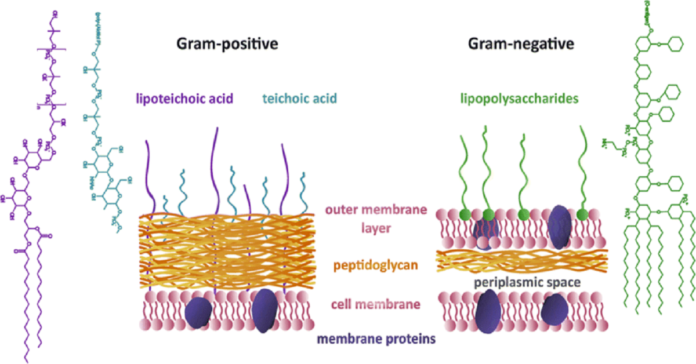Bacteria, as unicellular prokaryotic organisms, exhibit distinct cell wall structures that play a crucial role in their characteristics and interactions with the environment. Two major types, gram-positive and gram-negative bacteria, differ significantly in their cell wall composition and morphology.
This article explores the unique features of gram-positive and gram-negative cell walls, shedding light on their chemical makeup, structural nuances, and potential implications for bacterial harm. Understanding these differences is essential for deciphering the diverse strategies employed by bacteria in adapting to their surroundings and influencing their virulence, antibiotic resistance, and overall impact on human health.
Gram positive Cell Walls:
The main part of the gram-positive cell wall is a dense and uniform layer, primarily made up of peptidoglycan, ranging from 20 to 80 nm thick and visible under a high quality microscope like those listed here.
Additionally, it contains substantial amounts of teichoic acids directly linked to the peptidoglycan and lipoteichoic acid. Teichoic acids, formed from ribitol or glycerol connected by phosphate, carry a negative charge that helps regulate the movement of positive ions into and out of the cell. These acids also contribute to cell growth, preventing excessive wall breakdown and potential cell lysis.
Importantly, teichoic acids provide the cell with antigenic specificity, prompting a specific immune response and aiding in the identification of gram-positive bacteria through laboratory tests. In gram-positive bacteria, the cell wall is often closely pressed against the cell membrane, though in some cells, a thin periplasmic space is noticeable between the cell membrane and the cell wall. Lipoteichoic acid, with a similar structure, is attached to the lipid in the plasma membrane. Examples of gram-positive bacteria include streptococci and staphylococci.
Gram-Negative Cell Walls:
The gram-negative cell wall is structurally intricate, comprising minimal peptidoglycan layers and an outer membrane (OM) containing lipopolysaccharides (LPS), lipoproteins, and phospholipids. Lacking teichoic acids and featuring a smaller peptidoglycan content, gram-negative cell walls are more vulnerable to mechanical breakage.
The outer membrane serves as a defense barrier, thwarting phagocytosis and complement actions, while also resisting antibiotics and housing enzymes. Braun’s lipoprotein is a prevalent membrane component, connecting to the underlying peptidoglycan. Porin proteins enhance permeability, facilitating the passage of small molecules, whereas larger molecules, like vitamin B12, require specific carriers.
The large periplasmic space and unique LPS composition, including Lipid A, core polysaccharide, and O antigen, contribute to the distinctive characteristics of gram-negative bacteria, including negative surface charge and evasion of host defenses through dynamic changes in O side chains.
Difference between Gram Positive and Gram-Negative Cell Wall
Here are some important differences between gram positive and Gram-negative cell wall
| Characteristic | Gram positive cell wall | Gram negative cell wall |
| Chemical composition | Peptidoglycan
teichoic acids Lipoteichoic acids Mycolic acids and |
Lipopolysaccharide (LPS)
Lipoprotein Peptidoglycan Porin proteins |
| Overall thickness | Thicker (20–80 nm) | Thinner (8–10 nm) |
| Number of major layers | One | Two |
| Outer membrane | No | Yes |
| Porins | Absent | Present in Outer Membrane |
| Morphology | Cocci or spore-forming rods | Non-spore forming rods. |
| Periplasmic space | Narrow | Extensive |
| Permeability to molecules | More penetrable | Less penetrable |
| Bacteria | The bacteria contain gram positive cell wall called gram positive bacteria | The bacteria contain gram negative cell wall called gram negative bacteria |
| Mesosome | more prominent. | less prominent. |
| Toxin Production | Exotoxins | Exotoxins |
| Gram Staining | stain blue or purple on Gram’s staining. | stain pink or red on Gram’s staining. |
| Resistant to Physical Disruption | High | Low |
| Resistance to antibiotics | More susceptible | More resistant |
| Flagella Structure | Two rings in basal body | Four rings in basal body |
| Rigidity and Elasticity | Rigid and less elastic | Less rigid and more elastic |
| Example | Staphylococcus, Streptococcus, Enterococcus etc. | Escherichia, Salmonella etc. |
Which is More Harmful Gram Positive or Gram Negative?
Determining whether gram-positive or gram-negative bacteria are more harmful is not straightforward, as their impact depends on various factors. Both types of bacteria can cause infections, but their differences lie in the severity of the illnesses they may induce and their response to antibiotics. Gram-negative bacteria are often considered more resistant to antibiotics due to their complex cell wall structure, making treatment challenging.
Gram-negative bacteria possess endotoxins in their outer membrane, such as Lipid A in lipopolysaccharides, which can trigger strong immune responses and contribute to the severity of infections. On the other hand, gram-positive bacteria can produce potent exotoxins that contribute to their pathogenicity. Ultimately, the harmfulness of these bacteria depends on specific species, their ability to evade the host immune system, and the availability of effective treatments.
Conclusion
Understanding the distinctions between gram-positive and gram-negative cell walls provides valuable insights into the diverse world of bacteria. While both types have unique characteristics, their harmfulness depends on a myriad of factors, including their ability to evade the immune system, resistance to antibiotics, and specific virulence factors.
This complexity underscores the challenges in definitively labeling one type as more harmful than the other. In the ongoing battle against bacterial infections, this knowledge becomes a cornerstone for developing innovative and targeted therapeutic strategies.
Tailored approaches, considering the specific attributes of different bacteria, are crucial in navigating the intricate landscape of microbiology and medicine, ultimately advancing our ability to combat and control infectious diseases.




